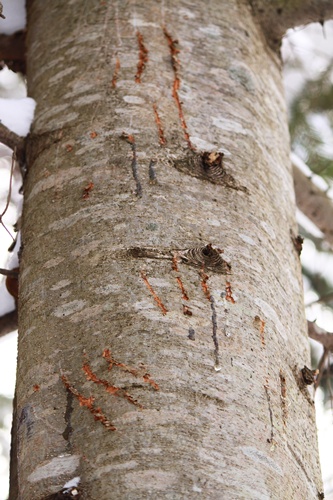During a walk on snowshoes, I found marks on a tree that were made by a climbing Ursus arctos yesonesis.
My first thought was that they must have been made last fall, but then I remembered that I passed this same place only a few days ago… (The marks were not there then.)
The heavy snowfall of the past few days made it impossible to find clear tracks. However, I did find places of slightly depressed snow in the area that could have been Ursus arctos yesonesis tracks.
Did an Ursus arctos yesonesis wake from hibernation early? Or perhaps it never hibernated at all.
Looking at the width between the claws, it does not appear that the bear was a big one.
Nonetheless, people who plan to go snowshoeing in the mountains should be cautious.
At any rate, young male Ursus arctos yesonesis generally awaken from hibernation in March.
(Pregnant females end their hibernation around early May.)
It’s about time to start carrying noisemakers.
Sap was seeping from the claw marks.
Photo: Marks made by a climbing Ursus arctos yesonesis Feb. 20
My first thought was that they must have been made last fall, but then I remembered that I passed this same place only a few days ago… (The marks were not there then.)
The heavy snowfall of the past few days made it impossible to find clear tracks. However, I did find places of slightly depressed snow in the area that could have been Ursus arctos yesonesis tracks.
Did an Ursus arctos yesonesis wake from hibernation early? Or perhaps it never hibernated at all.
Looking at the width between the claws, it does not appear that the bear was a big one.
Nonetheless, people who plan to go snowshoeing in the mountains should be cautious.
At any rate, young male Ursus arctos yesonesis generally awaken from hibernation in March.
(Pregnant females end their hibernation around early May.)
It’s about time to start carrying noisemakers.
Sap was seeping from the claw marks.
Photo: Marks made by a climbing Ursus arctos yesonesis Feb. 20
